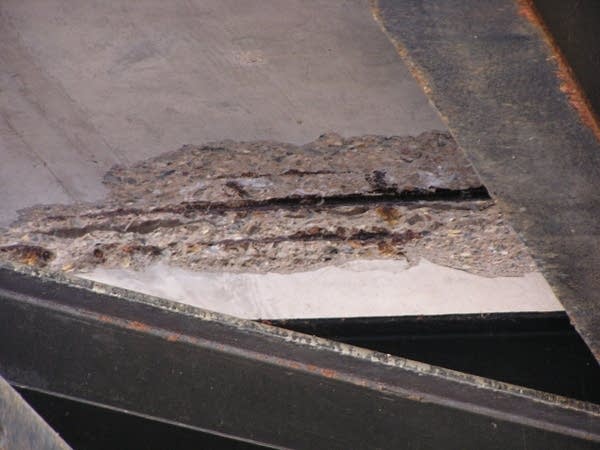Officials weigh next steps for the DeSoto Bridge
Go Deeper.
Create an account or log in to save stories.
Like this?
Thanks for liking this story! We have added it to a list of your favorite stories.

Inspectors weren't looking for the problem they ultimately discovered. A crew was using an ultrasonic device to measure the thickness and corrosion levels of steel connectors that can't be seen visually.
But state bridge engineer Dan Dorgan said those inspectors noticed a distortion, or bending, in the five foot by eight foot gussets that are visible holding the girders together.

"They did not find any corrosion. The plates are the full thickness they were originally built," said Dorgan. "But while they were doing that, that is when they noticed the distortion. It's fairly subtle. But realize of course our review of this is fairly heightened so they're going over things with a fine tooth comb."
Dorgan estimates the half inch steel connectors are bowed about a quarter of an inch. The bridge has other gussets, but by design, the plates in question bear more of a load than the others.
Turn Up Your Support
MPR News helps you turn down the noise and build shared understanding. Turn up your support for this public resource and keep trusted journalism accessible to all.
"When an engineer calculates the amount of stress going into the joint, it is one of the higher loaded joints in the bridge just because of the way the bridge is configured," explained Dorgan.

One key concern is that inspectors found problems in more than one of the gussets. The bridge has two trusses built on footings rising from the river. The force required to join the steel connections can cause the gussets to bend during construction.
But Dorgan said the fact that the bent plates showed up in different places with similar stress levels, and nowhere else, raised a red flag. "The bridge is symmetrical, so there's joints of identical construction. We found the same distortion in some of those other locations but not in the other gussets," Dorgan explained. "So that led us to conclude that something is occurring in terms of load that's causing this distortion."
The Highway 23 bridge, also called the DeSoto Bridge, was built in 1957. It was designed by Sverdrup & Parcel, the same firm that designed the failed I35-W bridge. The two bridges are nearly identical in appearance and construction.

Because of the similarities, inspectors looked over the Desoto Bridge August 3, 2007, two days after the I35-W bridge collapse and found no deficiencies.
State officials reviewed the DeSoto's design in January after federal officials indicated problems with the gussets may have contributed to the Minneapolis bridge failure. A subsequent on-site inspection in St. Cloud is when crews noticed the bent plates.
Acting Transportation Commissioner Bob McFarlin said the bridge will stay closed until officials are satisfied it's structurally sound.

"We are examining options for either repair of the bridge, but if repairs cannot be completed or if repairs are not possible, then the bridge will remain closed until it can be replaced," McFarlin said.
McFarlin did not give a timeline for either of those scenarios. Although previous inspections detected no deficiencies, McFarlin acknowledged that his department was eager to replace it before the current problems surfaced.
"This was a project to be accelerated," said McFarlin. "We were already on schedule or focusing on accelerating the replacement of this bridge to sometime in the next couple of years, which would be an acceleration of at up to five years."

The DeSoto Bridge was originally scheduled for replacement in 2015.
Minnesota has 59 bridges similar to the I35-W bridge design. State inspectors are methodically reviewing them for flaws. St. Cloud's DeSoto Bridge is one of 25 of those bridges remaining.
Officials expect to complete those inspections in June.



